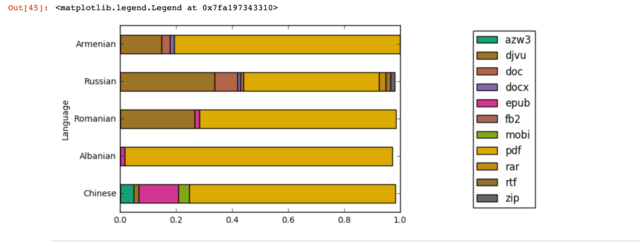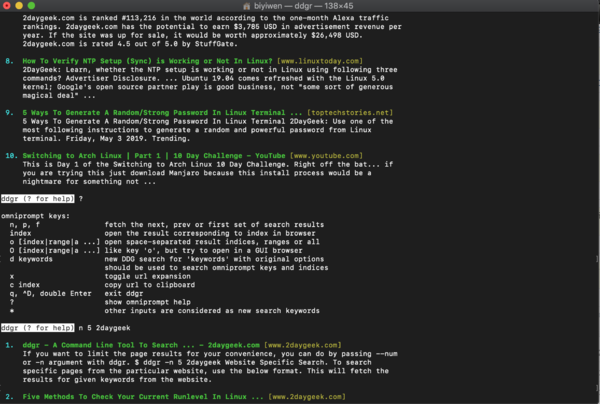User:)biyibiyibiyi(/Prototyping 03: Difference between revisions
| Line 82: | Line 82: | ||
====Configure VPN during summer? ==== | ====Configure VPN during summer? ==== | ||
is this what I am looking for? | |||
https://www.youtube.com/watch?v=15VjDVCISj0 | |||
==Annotation Tools== | ==Annotation Tools== | ||
Collecting some annotation tools for rapid prototyping, an idea for the final event launch. | Collecting some annotation tools for rapid prototyping, an idea for the final event launch. | ||
https://d3-annotation.susielu.com/#introduction | https://d3-annotation.susielu.com/#introduction | ||
Revision as of 20:39, 6 June 2019
Special Issue session with Bodó, in which prototyping was involved
2d diagram resulted from Bodó's LibGen data analysis. My intention was to survey file format composition of post-soviet states. The composition of file types of publications in Chinese language reflected the emergence of electronic publishing market, as indicated by diverse percentages in azw3 format used for Kindle.
Visit to Rietveld Library, where an instance of Bibliotecha is implemented
We did not do prototyping in this field trip however it was eye opening to see Bibilotecha being used actively in Rietveld library. I thought it fitted its purpose of fostering a reading community.
Watermarking, DRM w/André
This session is about revealing the materiality of digital book files. Worked on removing digital watermarks embedded in EPUB files downloaded from Verso.
Learned the name Ex Libris, which refer to stamps imprinted on books to signal proprietary right.
In context of digital publishing Ex Libris take form in digital formats. Unlike analog book plates to show signal proprietary right, digital watermarking tools, such as Ex Libris, become a tool for tracking digital files' distribution by attaching user/reader's name onto it.
The prototyping session then began as to understand more forms of digital watermarking tools and how to remove them for future distribution.
By looking into a EPUB file from Verso we discovered several examples of digital watermarking, provided by BooXtream to Verso. The watermarks can be categorized to two types, visible and invisible. The visible ones are visually identifiable on page footers, front pages disclaimers, by printing email address and names entered on Verso online account required for downloading. The invisible ones are embedded in the file structure. EPUB is a zipped file of html pages, each html contains contents of separate chapters. Invisible watermarks are embedded in filenames in the EPUB files (html, stylesheet, hyperlinks, etc). Other examples of invisible watermarking include time stamping and image meta-data watermarks.
To remove meta-data that contained user information, exiftool is used. this tutorial http://xahlee.info/img/metadata_in_image_files.html also showed how to remove geo data from meta data. Which reminded me that during middle/high school when digital camera was used and blogging was popular, I could see camera type metadata by right clicking onto images posted on the blogs...
Aside from removing watermarks as antithesis to copyrights, this prototyping session revealed EPUB file type as structurally interesting. tree command is able to show file structure in tree format. Several organizations to know about: Dublin Core Metadata Initiative, Intl Digital Publishing Forum, which aim is to collaboratively develop EPUB as file type to promote universal accessible e-book exchange.
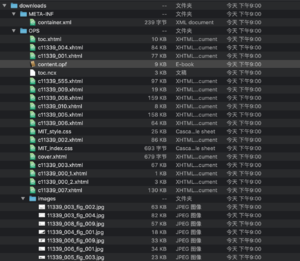 Unzipping EPUB file shows file structure and file types, content.opf contains metadata.
Unzipping EPUB file shows file structure and file types, content.opf contains metadata.
Tesseract OCR algorithm on browser w/Michael
Setting up Raspian
Motivation
During the last Special Issue we all set up Raspberry pi as server, running on Diet-pi. The web server was apache2. I wanted to set up Raspian for several reasons. Sheer curiosity to see the pi's ability other than being a server, such as being a wifi-hotspot (used in Bibilotecha.info project), using pi camera for home smart agents such as surveillance and automated helpers (pet feeding, plant watering, etc).
Aside from these sporadic interests, I would continue using my pi as server. Before I wiped out Diet-pi, I tried to configure apache2's fancyindex module, so that I can make a web gallery to showcase the projects I (and xpub) did. The try out was not successful. Fancyindexing appear to only apply to specific directories and not sub-directories. Anyway! It was fun to edit the configuration file, to notice it's similarity to other markdown languages.
As I noticed the Special Issue 08 mini site is running on Nginx, I wanted to install Nginx and try again. So I decided to wipe out the Diet-pi system as I felt frustrated with Apache2 configuration.
Process
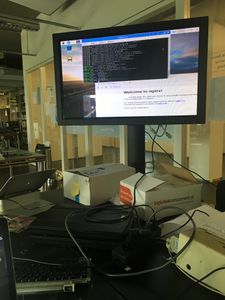
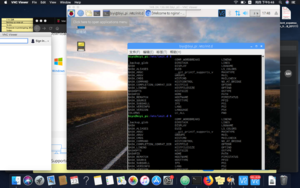 Playing with VNC
Playing with VNC
I discovered that Raspian's interface is quite revealing about its file structure. The folders start with root / and sub directories had designated purposes for storing specific file types. Browsing on Raspberry pi online development community I found a thread that explained the file system division. http://shumeipai.nxez.com/2018/01/05/directory-introduction-in-raspbian.html I glanced to basics of the naming protocol, i.e. /bin for binary file, /dev for drives (which reminded me that as we played with the dot matrix printer the driver file was stored in this folder) /mnt for mounting. Memorizing the structure and naming of the protocol is not necessary but it's good to have an impression in mind. As in the future if I develop projects, I will be navigating inside the folders, and I would want to know why I am placing certain files inside var/www but not in /bin.
So I thought in general Raspian is a transparent learning, prototyping tool.
Looking into projects, unlimited to Pi projects! small command line tools, social projects, DIY home project, etc
I looked up some hack documentations on making Raspberry Pi a device for machine learning, in particular learning image data, such as recognizing faces. I would want to explore potentials using machine learning and pi camera.
Reading from Linux China
As we become more adept at prototyping I looked for sources to familiarize myself with the larger contexts of what are people hacking/doing in open source hacker culture. I start by following a blog called Linux China. https://linux.cn/ There is a daily news feed, the scope is quite broad, from basics such as "20 linux commands to familiar with" to more advanced tutorials. Under the technical session there is a section for Pi projects. Below is my news brief about what I found interesting.
ddgr command
What is it good for? -for filtering ads, shortcut for content search without navigating to browser interface. Found other similar prototypes such as Googler, SoCLI (browse stackoverflow in terminal, and one for viewing Reddit on terminal..
Markdown editors for writers in humanities
zztlr https://linux.cn/article-10922-1.html look into after I acquire a linux computer. because I had some problems with using office softwares...will be nice to think of how can it relate to me writing on wiki, compiling writing for thesis.
Particulate Sensor using Pi and LCD
The purpose is to monitor particulate data in schools. I wonder if I would adapt it and use it in Beijing...? https://linux.cn/article-10939-1.html https://openschoolsolutions.org/mobile-particulate-matter-sensor/
Opensource Vegetarian Apps in Android
I always had problem managing my diet. This is something to look into. https://linux.cn/article-10926-1.html https://linux.cn/article-10926-1.html
Pi-hole
https://pi-hole.net/ will be interesting to work with since it involved network port as did in the last semester.
update on installing/configuring pi-hole(06-06-2019)
Configure VPN during summer?
is this what I am looking for? https://www.youtube.com/watch?v=15VjDVCISj0
Annotation Tools
Collecting some annotation tools for rapid prototyping, an idea for the final event launch. https://d3-annotation.susielu.com/#introduction

